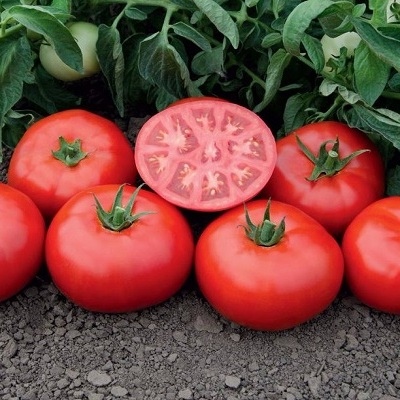
- Authors: Bejo Zaden B.V. (Netherlands)
- Year of approval: 2013
- Name synonyms: Tomsk
- Category: hybrid
- Growth type: determinant
- Appointment: fresh consumption
- Ripening period: mid-season
- Growing conditions: for open ground, for film greenhouses
- Transportability: good
- Bush size: undersized
The tomato, named after one of the prominent cities in Russia, generally lives up to its name. However, it gives good results only with a careful study of the peculiarities of culture and with competent actions. Therefore, this plant also requires the study of relevant information.
Description of the variety
Despite the seemingly underlined Russian name, the Tomsk tomato was bred in Holland. Its developer is Bejo Zaden B. V. In our country, the official registration of culture was made in 2013. She also has a foreign synonym - Tomsk. By its nature, such a tomato is classified as a determinant hybrid.
Therefore, he will not have any special problems with tall bushes and other things. The plant reaches a height of about 1 m. Large dark green foliage develops on it.
The main qualities of the fruit
At the very beginning of development, the berry has a simple light green tone. There are no spots in the region of the stalk. When ripe, it is a large red tomato weighing an average of 120-270 g. A flat-round ribbed fruit will develop on a simple inflorescence, and the stalk will be articulated. In the official description, keeping quality is guaranteed from 10 to 14 days.
Taste characteristics
The red flesh of this variety is invariably fleshy. High juiciness is also typical for her. But the density is usually at an average level. At least 6 seed chambers develop, which is why the seeds have a great influence on the perception of taste. In general, the Dutch have turned out to be quite a gastronomically worthy sample.
Ripening and fruiting
It is stated that Tomsk is one of the mid-ripening tomatoes. Between planting seedlings and getting ready-to-eat fruits, 70 to 75 days pass. This indicator, of course, can be influenced by the weather and the efforts of the gardeners themselves.
Yield
It was officially announced that the productivity of Tomsk is 3.6 kg per 1 sq. m, according to unofficial data - from 4.5 to 5 kg. There are certainly a number of varieties that are more fertile. But for a Dutch design, this is a tolerable drawback. Moreover, with good agricultural technology, the result will be achieved stably. The harvested crop is mainly used fresh.
The timing of planting seedlings and planting in the ground
The terms specific for this variety are not named in the official description, they are simply bypassed. Therefore, it is extremely important to do everything in the same way as for other mid-season tomatoes. The sowing date is chosen so that about 60-65 days have passed by the time the frost ends. They take into account the climatic features of the region in the first place. Usually, sowing is carried out in the first half of March, and a transplant to a permanent place, respectively, in May.

Growing tomato seedlings is an extremely important process, because it largely depends on whether the gardener will be able to harvest at all. All aspects must be taken into account, from seedbed preparation to planting in the ground.
Landing scheme
For 1 sq. m it is necessary to plant no more than 2-3 plants. It's even better to stick to the smallest number.Therefore, gardeners should choose loose hole layouts. Important: this does not cancel out the need to normalize flowers. Unofficial sources recommend a 400x600 mm landing system.

Growing and care
Since this is a hybrid, it makes no sense to disinfect purchased seeds, as well as to use independently collected planting material. But sorting with a saline solution and testing for germination are quite relevant. It is advised not to buy the soil, but to cook it yourself. An obligatory component of the soil mixture for seedlings is peat, without which it is impossible to achieve the proper looseness and drainage effect.
It is necessary to dive the seedlings after the appearance of 2 early leaves. If you are late with it, immunity will worsen, and the likelihood of tomato survival will be lower. On the main site, it is necessary to prepare loose light soil with a high level of fertility. To achieve large, uniform fruits, no more than 3 ovaries should be left per inflorescence. Of course, it is useful to pinch Tomsk and remove the lower leaves, as well as systematically water the plantings as the soil dries up.
For irrigation, use only warm water settled in a barrel. Frost resistance of this plant is high. It is thermophilic, but when heated to more than 32 degrees, pollen is not viable, and photosynthesis is ineffective. The effective development of a tomato is possible only with good lighting.




A plant needs different micronutrients at each stage of growth. All fertilizers can be divided into two groups: mineral and organic. Folk remedies are often used: iodine, yeast, bird droppings, eggshells.
It is important to observe the rate and period of feeding. This also applies to folk remedies and organic fertilizers.
Disease and pest resistance
High resistance to verticillium and fusarium wilting is officially declared. But the problem is that such properties are guaranteed only with proper agricultural technology. Preventive treatment can also be an important support measure, which it is foolish to neglect, despite all the described persistence.



























































































